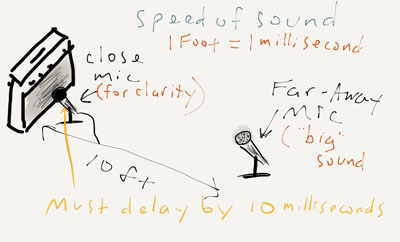Felix Broke The Sound Barrier In His Sky Dive – But What Does That Mean?
Felix Baumgartner broke a bunch of records in his historic sky dive from the edge of space, including becoming the first person ever to break the sound barrier, reaching a speed of about 834 miles per hour, without the aid of a craft of some kind. But what does it mean to “break the sound barrier?” And how can I use that knowledge in the audio recording and live sound worlds?
How Does The Speed Of Sound Relate To Audio Recording?
Well, basically breaking the sound barrier means that you move from a speed that is less than the speed of sound to a speed that is faster than the speed of sound. Since there are lots of variables involved that are ever-changing and rarely the same from one place to another (things like temperature, air pressure and density, etc.), it is generally accepted as a good approximation that the speed of sound is 1,125 feet per second at room temperature. That’s the same as 768 miles per hour, 1,235 kilometers per hour, 1 mile every 5 seconds, or 1 millisecond (ms) per foot.
But as people who are concerned about recording audio in our home studios, or doing live sound work, it’s the 1 millisecond per foot number that is most useful to us. How is it useful? Well, when we know that 1 foot = 1 millisecond, we can apply delays on certain sounds in our recording projects to correct for timing issues, especially when using multiple microphones on a single source.
An Example of The Speed of Sound In The Studio
For example, a lead guitar in a rock song needs to be very clear and “up-front,” but it also needs to sound huge. You can get the clarity and up-front part simply by placing a microphone very close to the amplifier grill – like just an inch or two.
Over the years it has become pretty standard to use a dynamic mic like the Shure SM57 for this. But that won’t give you the large/huge sound that you want. For that you need a far-away mic, something placed about 10-15 feet away. At that distance a large diaphragm condenser mic would work well. An AKG C214 would work well for this due to its ability to withstand loud sound signals.

So now you have 2 microphones recording a single sound, the electric guitar. But one of the 2 mics is 10 or 15 feet further away, and the sound will reach them at different times.
Blending the sound from both mics will reduce or eliminate the clarity and attack of the guitar that we need because of the delay of the sound going into the far-away mic.
But armed with our new-found knowledge about the speed of sound, we can compensate for the delay by simply adding some delay to the close mic. In the studio you can use a delay effect in your recording software/DAW (such as Reaper or Pro Tools). If recording live, or otherwise using outboard gear, you can use a hardware delay unit such as the TC Electronic D-Two.
How much delay do we need? Let’s go back to our speed-of-sound number – 1 millisecond = 1 foot. So if the far-away mic was 10 feet away, we add 10 milliseconds to the close-up mic to compensate for the distance difference in the mics. Now we have both a clear AND a large-sounding lead guitar sound!
See? Now you know how Felix Baumgartner breaking the sound barrier relates to recording audio. You’ll find other uses for this knowledge as you do more and more recording or live sound.

Ken, great information and I love the way you tied it into the news of the day! I now have some ideas on miking a GTR amp I did not think of before.
Thanks and keep up the good work!
Thanks Allen! It was actually my wife’s idea;). I’m glad it was helpful. Say hi to Sheri for me!
Ken